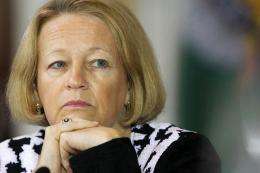Chairman of the US Securities and Exchange Commission Mary Schapiro listens during a meeting on July 18, at the Treasury Department in Washington, DC. US regulators on Tuesday announced new rules aimed at shedding light on the secretive industry of computerized high-speed trading, which has been blamed for destabilizing financial markets.
US regulators on Tuesday announced new rules aimed at shedding light on the secretive industry of computerized high-speed trading, which has been blamed for destabilizing financial markets.
The Securities and Exchange Commission said the new rules were designed to help it deal with events like the "flash crash" of May 6, 2010, when the Dow Jones Industrial Average fell nearly 1,000 points in a few minutes.
"May 6 dramatically demonstrated the need to enhance the SEC's ability to quickly and accurately analyze market events," SEC chairman Mary Schapiro said in a statement.
Under the new rules, traders whose market transactions exceed two million shares or $20 million per day will need to disclose more information about themselves to the SEC, the agency said.
"The large trader reporting rule will significantly bolster our ability to oversee the US securities markets in a time when trades can be transacted in milliseconds or faster," Schapiro said.
The SEC drafted the new rules after a lengthy analysis of the "flash crash", which was triggered when a trader using a high-speed trading program placed an order to sell $4 billion of futures contracts.
Other high-speed trading programs followed suit, leading to a huge sell-off in which the Dow plunged close to 1,000 points, although it recovered most of its losses within minutes.
The incident spooked investors and led to criticism of high-speed trading firms, who have been estimated to account for as much as 70 percent of all trades conducted on US stock markets.
(c) 2011 AFP





















